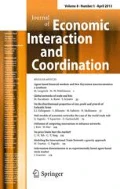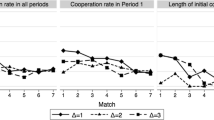Abstract
We follow the example of Gossner et al. (Econometrica 74(6):1603–1636, 2006) in the design of a finitely repeated 2-player coordination game with asymmetric information. Player 1 and Player 2 and Nature simultaneously decide whether to play 0 or 1 and successful coordination requires that all actions coincide. Nature’s moves are known only by Player 1, while Player 2 observes only the history of Nature and Player 1. In such a theoretical set up, efficient transmission of information takes place when Player 1 uses block codification through signalling mistakes. With this in mind, we test coordination in the lab. We first model and establish the appropriate sequence length played by Nature and the block strategy for lab implementability. We show that the majority rule with 3-length is the optimal block codification for a 55-length sequence. Experimental data supports the main results of the original model with respect to the codification rule using signalling mistakes.



Similar content being viewed by others
Notes
See Farrell and Rabin (1996) for an exhaustive survey.
In general, \(\left( \begin{array}{c} m \\ t x \end{array}\right) \) is defined as \(\Gamma (m+1)/(\Gamma (x+1)\Gamma (m-x+1))\). Being \(\Gamma (m)\) the Euler gamma function that satisfies \(\Gamma (m)=\int _{0}^{\infty } t^{m-1}e^{-t}dt\). For \(m(1-q)=1\), we consider \(\left( \begin{array}{c} m(1-q) \\ m(1-q)\frac{1}{2} \end{array}\right) \)\(=2\). That means that with one digit is possible to construct the two basic sequences: 0 and 1.
The entropy is also useful to approximate a combinatorial number. For \(0<x<1\), the combinatorial number \(\left( \begin{array}{c}m\\ mx\\ \end{array}\right) \) is upper bounded by \(2^{mH(x)}\).
\(\mathbb {Z}\) denotes the set of positive integer numbers.
The possible binary sequences of length 3 are: (0, 0, 0), (0, 0, 1), (0, 1, 0), (1, 0, 0), (1, 1, 0), (1, 0, 1), (0, 1, 1) and (1, 1, 1). There are four sequences with majority rule 0, and also four with majority rule 1. The probability of the majority rule ‘equals 0’ is given by \(prob(majority=0)=prob(000\cup 001\cup 010\cup 100)=4\frac{1}{8}=\frac{1}{2}\). Similarly, the probability of the majority rule ‘equals 1’is equal to \(prob(majority=1)= prob(110\cup 101\cup 011\cup 111)=4\frac{1}{8}=\frac{1}{2}\). Thus, the probability of two consecutive blocks having the same majority is \(\frac{1}{2}\). The probability of an intended mistake (say x) becoming a random match is equal to: \(P(x=majority=0)P(majority=0)P(majority=0) + P(x=majority=1)P(majority=1)P(majority=1) = \frac{1}{4}\).
See the translated version from the original in Spanish in “Appendix 2”.
Subjects were informed about the computerized random process as being like tossing a coin.
Wilcoxon signed-rank test for the equality of medians: \(z=3.701, p=0.0002\).
In this algorithm, the applied measure of distance is the sum of absolute differences, known as the L1 distance. Each centroid is the component-wise median of the points in that cluster: \(d(x,c)=\sum _{j=1}^{p} |x_{j}-c_{j}|\).
It is applied Wilcoxon signed-rank test for the equality of medians.
References
Agastya M, Bag PK, Chakraborty I (2014) Communication and authority with a partially informed expert. RAND J Econ 45(1):176–197
Agastya M, Bag PK, Chakraborty I (2015) Proximate preferences and almost full revelation in the Crawford–Sobel game. Econ Theory Bull 3(2):201–212
Allon G, Bassamboo A (2011) Buying from the babbling retailer? The impact of availability information on customer behaviour. Manag Sci 57(4):713–726
Allon G, Bassamboo A, Gurvich I (2011) “We will be right with you”: managing customer expectations with vague promises and cheap talk. Oper Res 59(6):1382–1394
Blume A, Ortmann A (2007) The effects of costless pre-play communication: experimental evidence from games with Pareto-ranked equilibria. J Econ Theory 132:274–290
Charness G, Grosskopf B (2004) What makes cheap talk effective? Experimental evidence. Econ Lett 83(3):383–389
Crawford V, Sobel J (1982) Strategic information transmission. Econometrica 50(6):1431–1451
Crawford V (1998) A survey of experiments on communication via cheap talk. J Econ Theory 78:286–298
Devetag G, Ortmann A (2007) When and why? A critical survey on coordination failure in the laboratory. Exp Econ 10(3):331–344. https://doi.org/10.1007/s10683-007-9178-9
Duffy S, Hartwig T, Smith J (2014) Costly and discrete communication: an experimental investigation. Theory Decis 76(3):395–417
Farrell J, Rabin M (1996) Cheap talk. J Econ Perspect 10(3):103–118
Gilligan TW, Krehbiel K (1989) Asymmetric information and legislative rules with a heterogeneous committee. Am J Polit Sci 33:459–490
Gossner O, Hernández P, Neyman A (2003) Online matching pennies. Discussion paper 316, The Hebrew University of Jerusalem
Gossner O, Hernández P, Neyman A (2006) Optimal use of communication resources. Econometrica 74(6):1603–1636
Grossman SJ (1981) The informational role of warranties and private disclosure about product quality. J Law Econ 24(3):461–483
Hertel J, Smith J (2013) Not so cheap talk: costly and discrete communication. Theory Decis 75(2):267–291
Kartik N (2005) Information transmission with almost-cheap talk. Technical report. www.najecon.org
Krishna V, Morgan J (2001) Asymmetric information and legislative rules: some amendments. Am Polit Sci Rev 95(2):435–452
Milgrom PR (1981) Rational expectations, information acquisition, and competitive bidding. Econometrica 49(4):921–943
Shane F (2005) Cognitive reflection and decision making. J Econ Perspect 19(4):2542. https://doi.org/10.1257/089533005775196732
Sobel J (2010) Giving and receiving advise. In: Presented at the econometric society 10th world congress. Mimeo, University of California San Diego
Sobel J (2012) Complexity versus conflict in communication. In: 46th annual conference on information sciences and systems (CISS). IEEE, pp 1–6
Watson J (1996) Information transmission when the informed party is confused. Games Econ Behav 12(1):143–161
Author information
Authors and Affiliations
Corresponding author
Additional information
The authors thank comments and discussion of participants in EEA-ESEM (Toulouse, 2014), UECE Lisbon Meeting-2015, and ExperiMetrix Workshop (Alicante, Spain, 2015). A. García-Gallego acknowledges financial support by the Spanish Ministerio de Economía y Competitividad (Project ECO2015-68469-R) and the Universitat Jaume I (Project P1.15-1B2015-48). P. Hernández would like to thank the Spanish Ministerio de Economía y Competitividad (Project ECO2014-58297-R) for financial support.
Appendices
A Appendix 1: Tables
B Appendix 2: Instructions to subjects (translated from Spanish)
You are going to participate in an experimental session that will give you the possibility to earn some money in cash. How much money you will ultimately take will depend on luck and your and others’ decisions. Please switch off your mobile phone and leave your things to one side. For your participation in the session you need just the instructions and the computer on your desk. Please raise your hand if you have any questions, and one of us will see to it privately.
In this experiment, you will be paired with another participant, who will not change throughout the session. None of you will know the identity of the other throughout the session. A pair is composed of two types of participants: ‘Type 1’ and ‘Type 2’. At the beginning of the session, the computer will randomly assign you one of the two roles and display it on your screen. The experiment is divided into two parts of 55 rounds each. Both parts are identical. At the beginning of each part, the computer will randomly determine, for every round, a value that may be either 0 or 1. This zero/one 55-sequence will be called ‘Prize’. In each round, the probability that the action of the Prize is associated to 0 or to 1 is exactly the same: 50% (it is like tossing a coin). The value of Prize will be determinant for your earnings in every round, according to the rules that follow.
Each round, your decision making consists in choosing either 0 or 1. In each pair, the two participants simultaneously choose either 0 or 1 taking into account that:
-
If the decisions of both participants coincide with that of the Prize, they both get 1 ECU each in that round.
-
If at least one decision within the pair does not coincide with that of the Prize, then both get nothing in that round.
At the beginning of each part, you will have 3 min to communicate with your partner through a chat. You may end the chat at any time before the end of minute 3 by clicking on the option ‘Exit from the chat’. Every message sent through the chat will be recorded and carefully analyzed by the experimenters. At the end of each round, your screen will display information concerning the value of the ‘Prize’ (0 or 1), the decision of your partner (0 or 1) and your own decision in that round.
To be ‘Type 1’ or ‘Type 2’ has consequences:
-
If you are ‘Type 1’, at the beginning of each 55-rounds part, and after using the chat to communicate with your partner, you will be aware of the 55-rounds sequence of values of the Prize that corresponds to that part of the session. You will be the only one to know the Prize.
-
If you are ‘Type 2’, you will be aware of the value of each action of the Prize once both participants have decided, that is, at the end of each round.
Moreover, ‘Type 2’ knows that just ‘Type 1’ will be aware of the Prize sequences for each Play just after the 3-min chat. Also, Type 1 knows that Type 2 will be aware of Prize’s and Type 1’s actions at the end of each round, immediately after the decision of the two participants.
Earnings
At the end of each part of the experimental session, the number of winning rounds will be revealed to the participants. At the end of the session, you will be paid in cash your total payoff, that is, the total number of rounds, considering the two parts, in which you won 1 ECU. The exchange rate between ECUs and Euros is 1 ECU \(=\) 1/4 Euro.
C Appendix 3: Teamwork Test (TwT)
The 25 questions chosen from the general TwT are presented below. The answer to each question was categorical so that the subject had to choose among these 4 possibilities:“Always”, “Sometimes”, “Occasionally”, “Rarely”. Within parenthesis we specify the category to which each question belongs.
-
Q1.
Do others think you are trustworthy? (Trust)
-
Q2.
Do you generally believe what an authority tells you? (Trust)
-
Q3.
Do you mind waiting for others to finish their work? (Patience)
-
Q4.
Do you tell people that you have been waiting for them for a long time? (Patience)
-
Q5.
Do you find yourself interrupting others? (Respect)
-
Q6.
Do you give another person your full attention when speaking with him or her? (Respect)
-
Q7.
Do you consider it disrespectful to ignore another person? (Respect)
-
Q8.
Do you take on whatever task given to you without complaint? (Cooperation)
-
Q9.
Are people often telling you that you cause problems? (Cooperation)
-
Q10.
Is your idea of cooperation telling people what to do? (Cooperation)
-
Q11.
Do you share your space and possessions? (Cooperation)
-
Q12.
Would you rather voice your opinion via email than in person? (Interaction)
-
Q13.
Do your like to be the leader in a group project? (Control)
-
Q14.
Are you frustrated if someone else has power over you? (Control)
-
Q15.
Do you get upset when things dont go as you planned them? (Control)
-
Q16.
Do you easily persuade people to believe you? (Persuasion)
-
Q17.
Do you grab all the acclaim for group success? (Responsibility)
-
Q18.
Do you consider yourself a perfectionist? (Perseverance)
-
Q19.
Can you easily admit if you are wrong in a situation? (Perseverance)
-
Q20.
Can you move on from disappointments quickly? (Perseverance)
-
Q21.
Do you usually achieve your goals? (Determination)
-
Q22.
Do you drop out of projects, programs, or groups? (Determination)
-
Q23.
Are you understanding when unexpected problems arise? (Understanding)
-
Q24.
Can you sit and read a book for longer than 30 min? (Listening)
-
Q25.
Have people often told you that you are a good listener? (Listening)
Rights and permissions
About this article
Cite this article
García-Gallego, A., Hernández-Rojas, P. & Rodrigo-González, A. Efficient coordination in the lab. J Econ Interact Coord 14, 175–201 (2019). https://doi.org/10.1007/s11403-017-0214-3
Received:
Accepted:
Published:
Issue Date:
DOI: https://doi.org/10.1007/s11403-017-0214-3




